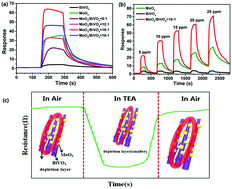当前位置:
X-MOL 学术
›
New J. Chem.
›
论文详情
Our official English website, www.x-mol.net, welcomes your feedback! (Note: you will need to create a separate account there.)
A novel composite of α-MoO3/BiVO4 for triethylamine selective detection
New Journal of Chemistry ( IF 3.3 ) Pub Date : 2020/01/09 , DOI: 10.1039/c9nj06198c Shouli Bai 1, 2, 3, 4, 5 , Jingyi Han 1, 2, 3, 4, 5 , Xiangxiang Fan 5, 6, 7, 8 , Jian Guo 1, 2, 3, 4, 5 , Ruixian Luo 1, 2, 3, 4, 5 , Dianqing Li 1, 2, 3, 4, 5 , Aifan Chen 1, 2, 3, 4, 5
New Journal of Chemistry ( IF 3.3 ) Pub Date : 2020/01/09 , DOI: 10.1039/c9nj06198c Shouli Bai 1, 2, 3, 4, 5 , Jingyi Han 1, 2, 3, 4, 5 , Xiangxiang Fan 5, 6, 7, 8 , Jian Guo 1, 2, 3, 4, 5 , Ruixian Luo 1, 2, 3, 4, 5 , Dianqing Li 1, 2, 3, 4, 5 , Aifan Chen 1, 2, 3, 4, 5
Affiliation

|
One-dimensional α-MoO3 nanorods were synthesized by a hydrothermal method and BiVO4 nanoparticles were grown directly onto the α-MoO3 nanorods using a simple metal organic decomposition process in order to construct an α-MoO3/BiVO4 composite with a heterojunction, for the fabrication of a rapid response triethylamine (TEA) sensor. The morphology and structure of the composite were characterized via various spectral techniques and the sensing properties of the sensor for TEA were investigated via resistance measurements. The results showed that the response of the 16Mo/Bi composite to 20 ppm TEA was 1.86 times and 15 times higher than those of α-MoO3 and BiVO4, respectively, at an optimum operating temperature of 125 °C. The enhancement can be ascribed to the existence of a heterojunction between α-MoO3 and BiVO4, creating an additional barrier at the interface of the heterojunction, and this increases the resistance of the composite in air and decreases the resistance in TEA, thus enhancing the response of the composite to TEA.
中文翻译:

用于三乙胺选择性检测的新型α-MoO3/ BiVO4复合物
一维α-的MoO 3个纳米棒通过水热法合成,BiVO 4纳米颗粒直接生长到α-的MoO 3个使用简单的金属有机分解过程中为了构建α-的MoO纳米棒3 / BiVO 4复合带异质结,用于制造快速响应的三乙胺(TEA)传感器。通过各种光谱技术对复合材料的形貌和结构进行了表征,并通过电阻测量研究了TEA传感器的传感特性。结果表明,16Mo / Bi复合材料对20 ppm TEA的响应是α-MoO的1.86倍和15倍。3和BiVO 4的最佳工作温度分别为125°C。增强可以归因于α-的MoO之间的异质结的存在3和BiVO 4,创建在异质结的界面的附加屏障,并且这增加了复合材料在空气中的阻力,并且降低茶叶中的电阻,从而提高了复合材料对TEA的响应。
更新日期:2020-02-12
中文翻译:

用于三乙胺选择性检测的新型α-MoO3/ BiVO4复合物
一维α-的MoO 3个纳米棒通过水热法合成,BiVO 4纳米颗粒直接生长到α-的MoO 3个使用简单的金属有机分解过程中为了构建α-的MoO纳米棒3 / BiVO 4复合带异质结,用于制造快速响应的三乙胺(TEA)传感器。通过各种光谱技术对复合材料的形貌和结构进行了表征,并通过电阻测量研究了TEA传感器的传感特性。结果表明,16Mo / Bi复合材料对20 ppm TEA的响应是α-MoO的1.86倍和15倍。3和BiVO 4的最佳工作温度分别为125°C。增强可以归因于α-的MoO之间的异质结的存在3和BiVO 4,创建在异质结的界面的附加屏障,并且这增加了复合材料在空气中的阻力,并且降低茶叶中的电阻,从而提高了复合材料对TEA的响应。


























 京公网安备 11010802027423号
京公网安备 11010802027423号